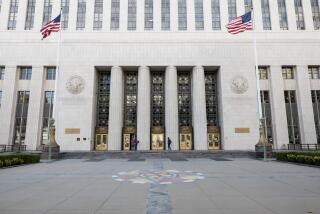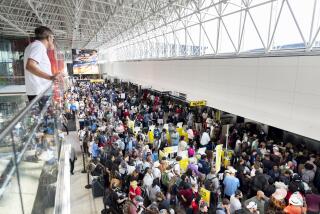U.S., Firms Overreacted to Y2K Fix, Critics Say
- Share via
After the years of work and billions of dollars spent repairing the 2000 computer glitch, the technological tranquillity of New Year’s Day has raised a new concern that the United States overreacted to this problem.
While companies and government agencies in the United States spent an estimated $150 billion to $225 billion repairing the problem, countries like Russia and China, which spent relatively minor amounts, seemed to clear the big New Year’s Day hurdle with equal success.
It is still too soon to say that the Y2K transition has passed without mishap, but the lack of international trouble is already being interpreted by some computer experts as evidence that the United States overreacted.
“I think we have been had,” said Paul Strassmann, former chief information officer of the Pentagon, Xerox Corp. and General Foods. “The United States has been ransomed. The psychology of the Y2K funding was basically confronting management with extreme demands for which there was no rationale whatsoever.”
David Starr, chief information officer at 3Com Corp., said Saturday that even though the Y2K glitch “absolutely was a problem,” U.S. expenditures on Y2K fixes were “out of proportion by orders of magnitude.”
Even those pundits and experts who have spent the last few years criticizing the lack of action by companies and governments on the Y2K front, said there certainly was some padding and excess in the repair effort.
“Did we waste our money?” asked Leon A. Kappelman, a professor of business information systems at North Texas University and a longtime commentator on the 2000 problem. “No; however, there was certainly some overspending. There’s no doubt there was some waste.”
The public and corporate policy underlying the Y2K remediation effort in recent years was to fix every critical computer that could cause social or economic disruption or jeopardize public safety.
If the United States did go overboard, experts said it was almost inevitable because of a combination of cultural, economic and institutional factors unique in this country: the nation’s singular dependency on computers; a propensity to avoid risk; and the very real threat of lawsuits against companies whose products caused havoc.
The United States “is computer crazy,” Strassmann said. “We spend more on technology than anybody else in the world, and we have an increased sense of vulnerability which has not yet penetrated the rest of the world.”
Most experts agree that the United States was by far the most aggressive and probably the best-prepared country on the 2000 problem.
Lou Marcoccio of the Gartner Group, a Stamford, Conn.-based research and consulting firm, estimates that Russia spent as much as 100 times less than the United States on the glitch. The British government spent about $695 million--less than one-tenth of the $8.4 billion spent by the U.S. government.
Experts on the 2000 issue have long warned that problems could crop up overseas because of the late starts by many countries and the relatively small amounts of money they spent. But as it turned out, computer operators around the globe yawned their way into the new century.
The lack of disruption is illustrated on a Web site operated by the United Nations’ Year 2000 Coordinating Council. Among more than 200 countries sending updated reports, covering systems ranging from transportation to telecommunications, only one has reported any trouble: the small African nation of Gambia. It reported minor trouble with some government computer systems.
Some experts said the work to repair the 2000 problem was always covered by a cloud of hype generated by 2000 consulting companies and corporate computer departments anxious to boost their own budgets.
“I know a lot of computer replacement was done for Y2K when there was no real reason,” Kappelman said.
Starr agreed that top technology executives took advantage of the glitch to push through costly system upgrades.
Media attention on Y2K exerted far greater pressure on technology chiefs and corporate leaders to fix the Y2K problem than other everyday glitches, Starr said.
“If you were unprepared for Y2K you were going to be fired,” Starr said. “Every corporate board member had this on their checklist.”
There were other factors as well that pushed companies and government agencies to aggressively attack the problem, including the fact that the United States is one of the most litigious countries in the world.
Trial attorneys saw a potential gold mine in litigation against faulty software and some experts warned that companies might spend more fending off lawsuits than rehabilitating code. The specter sent technology companies on a political campaign in Congress to get legal protection from such suits.
Congress eventually did pass a bill that helps limit companies’ liability. But the continuing fear of litigation led many companies to repair their equipment to a higher standard, one that could withstand both technological and legal assault.
The lack of affordable Y2K insurance coverage also deprived U.S. companies of the primary mechanism by which they prepare for--and assess the risks of--all sorts of calamities, from earthquakes to oil tanker explosions.
One of the most panic-inducing elements of the Y2K bug was the possibility that so many separate computer systems might fail at the same moment.
But that aspect of the problem often seemed to blind executives and government officials, some experts said, prompting them to abandon the common sense they apply to the glitches that are everyday occurrences in the Information Age.
John Koskinen, chairman of the President’s Council on Year 2000 Conversion, argued that the effort was not excessive because of the complexity of the problem in the United States.
The lack of significant difficulties “is not an indication that there wasn’t a problem underlying it all,” Koskinen said. “It is an indication that if you mount . . . this national coordinated effort, you can solve a very complicated problem.”
There is still plenty of time for failures to appear. The Gartner Group has estimated that only about 10% of failures will occur within a few days of Jan. 1. Many more are likely over the coming year as computers stumble on the two-digit abbreviation for 2000--”00”--that is at the heart of the problem.
*
Times staff writer Elizabeth Shogren contributed to this story.







